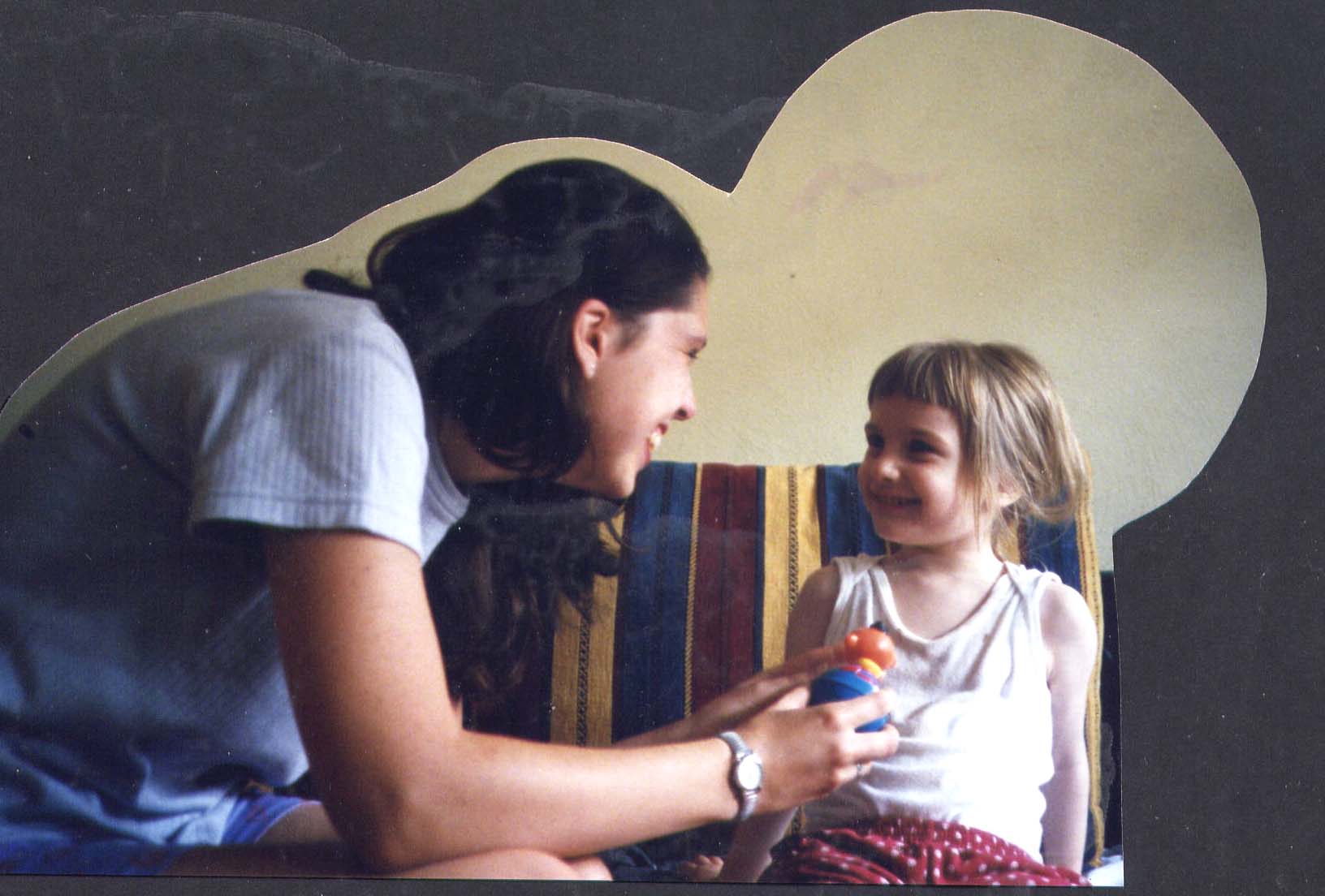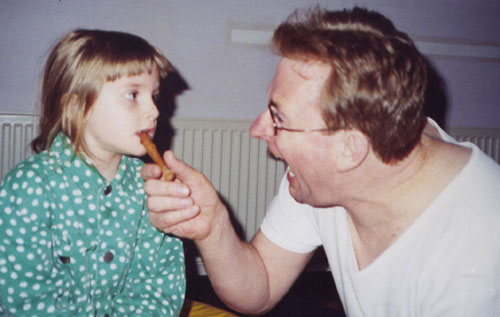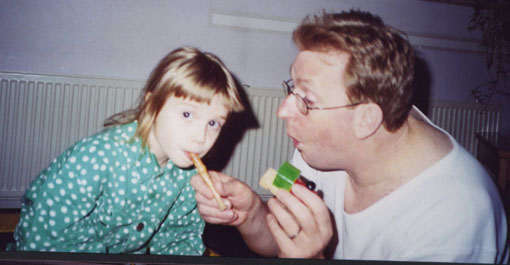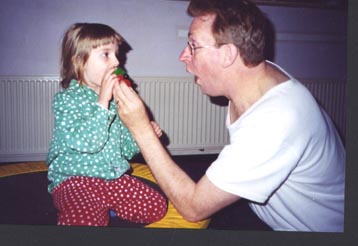THE START UP COURSE
The start-up course in Rotterdam has been of great importance for our intensive home program. It was the first human and friendly help we got up till that moment. It was also the first time somebody truly understood and believed in our and Dejana’s potential to fight against the difficulties she encountered at that moment. Both the Son-Rise team and we, believed we would go far beyond what many doctors had predicted. Through the Rotterdam “start-up” course we obtained the necessary strength to not depend on chance. We learned that HOPE is the motor for every achievement. For that we thank the Son-Rise team and especially Brynn and William Hogan who led us into the world of unlimited possibilities and who taught us to believe in the huge natural potential every one of us has, Dejana in particular!
The course also taught us how to ask and get help. Already the first weekend after the course finished we were able to give a presentation to people, who we thought could help us. It was unbelievable to find out that before we knew it, we had a wonderful team of enthusiastic volunteers who, together with us, started a very intensive stimulation program for our Dejana. Before the first day of our course we never could have believed it was possible to find even one person willing to help us with the stimulation program, let alone that it was possible to form a complete team of volunteers, some of them have already been helping us for 4 years now!! But on the evening of the fifth course-day I knew it was possible! Such a change in only five days was really very special.
Son-Rise not only gave us HOPE and BELIEF in the program, it also gave us a boost of energy that we could pass on to others, it motivated and attached them to us and Dejana in a very positive way. That was a crucial moment for all of us. We would never have such a wonderful team of volunteers if we had not attended that “start-up” course in Rotterdam. Our home-program would have gone a completely different way. Maybe even there would not have been a home-program any more, for without the help of all these kind people, it is not possible to maintain and endure such an intensive home-program.Son-Rise definitely changed our lives. I think it enriched mine, notwithstanding all the difficulties we encountered on our “reaching for the stars” road.Besides this really major change in our lives, “Rotterdam” taught us many more things we have been able to use when working with Dejana. Most of the ideas are, even now, useful in combination with other and different programs we presently use for our daughter.
The main principals and attitudinal cornerstones of ‘Son-Rise” are extremely useful when working with children of all ages and all kind of developmental challenges. Using them always gives visible results and the whole process of learning and exercising makes it more friendly and fun to all of us.

|

|
Some of the “Son-Rise “ principals we were taught at the course were:
To understand the GIFT of a special child and to change the perspective of your traditional view. A special child is not a curse but a gift, which challenges us to express the most powerful and humane part of ourselves. If we can adopt this new vision every problem will become an opportunity for some inspiring work and not for defeatism. The PARENT is a child’s best resource, the most powerful, dedicated and loving. That fact is often dismissed in many professional circles. It is known that “experts” do not know a child as well as its parents, because they see the child for a very limited time and their most important view is based on existing “literature”. Our child is just one of many children for them. But parents have a unique position in the child’s world and their motivation is great and powerful. The CHILD is a teacher. We can learn a lot just by observing her; follow her interests, her motivations and the guidelines she gives us. This can teach us to discover the best way to handle all development stages: To have HOPE!!
MAIN PRINCIPLES
From the many attitudinal cornerstones we have learned at the Son-Rise course in Rotterdam and which we have used abundantly for more than two years, there are, even today, a few that we apply in our new intensive home program for Dejana, they are:
1 ___ Love and acceptance
It was of the utmost importance in the first two years of our home-program because Dejana’s behaviour at the time was very much autistic. We allowed Dejana to have full control in her special playing room. We just followed and mirrored her in everything she did, walking in circles in the room, biting and chewing her small reading books, throwing her building blocks on the floor, switching the light on and off endlessly, jumping on the trampoline together, and we used every single moment to get eye contact. It was a period of absolute acceptance and observation. I learned a lot from her then, and she lost much of her irritation and screaming spells.
2 ___ Being non judgemental
It means that we do not label the behaviour of a child as good or bad, right or wrong, nice or pitiful. It is better to realise that everything she does must have some reason and that instead of forbidding behaviour that we do not like or want, we do better if we try to find the reason for her doing it. Why does she cry? Why are her hands constantly in her mouth? Why doe she switch the light on and off? Why does she chew her book? If we find the answer to all those questions we can offer her alternatives that are more acceptable, and or agreeable, for us both. Dejana for example used to chew on books with hard pages. Instead of forbidding that as bad behaviour we imitated her. That helped me to find out that the reason for her chewing on that type of book had to do with tension of muscles in her jaw. Because of that knowledge I later on got the idea to start with mouth and tongue massage. Even now massage proves to be one of the most important treatments and therapies in Dejana's program. In this way our Non Judgemental attitude led to very useful knowledge.In every session - spending two hours together with her in the special playing room - we used tremendous
3 ___ Energy, enthusiasm and excitement.
We used everything we could think of like sudden or unexpected movements, voice variations, surprise, happy and smiling expressions of the face, eye contact on her level, creativity and funny activities to get her attention. They were the key factors in every session. Our aim was to dynamically get the Dejana's attention and to transfer that into action from her. At the same time we rewarded every of her rare attempts for attention and contact with us explicitle and very abundantly. Sometime we rewarded her with our voice, sometimes with our gesture; sometimes we used both or more! We talked to her in different voices; high or low-pitched, unusually pitched, with a nasal effect, whispering, with or without grimaces. Gradually we learned to use Enthusiasm and Excitement in everyday activities like brushing teeth, eating, dressing and going to the toilet.
4 ___ To be present
Was for me the most difficult attitude to learn. To be present in the moments you play without regrets for the past or fears for the future, is essential for the quality of the playing exercises. The child feels more at ease and it is nicer and more motivating as well. Creating a friendly atmosphere for both, opens the window of creativity, good humour and progress on the road to the stars. To be present means not to think about how much time it will take for your child to learn what you are trying to teach her, do not even wonder if she will learn it at all. It means not being sceptical, worried or disappointed as long as you play with her.
5 ___ Being a happy detective
Observe your child carefully and with heightened sensitivity when you play with her. Watch for the clues to help us understand her behaviour and routines more. Forget about your prejudices about the definition of symptoms and prognoses. View every situation and movement of your child with an open and free mind. Does she look at one point unconsciously, or does she look at that particular point because of some sensation like a shadow, a movement, or a colour? Doe she bite her hand out of frustration - like most people seem to think - or is it in fact a reaction on some kind of sensation she feels in her hand. Maybe it is a good moment to give her a hand massage. It is important to realise that a child always does something even when she stares at a particular point. Something is happening inside of her head and if we discover WHAT it is, we open the door into her world. In this world of hers the answers to many of our questions can be found.
6 ___ Believe in the child
This was one of the easiest tasks for me. I believed more in Dejana then in the prognoses and definitions of the so-called professionals. This belief was the decisive factor in continuing the stimulation program in spite of problems, many ups and downs, doubts and disappointments. Because if you do not believe that your child can break the bonds of her apparent limitation you will never inspire her to do so. If you do not believe that one can surpass the limtis that are attributed to her developmenet by professionals, do not even think to start an intensive stimulation program, because then it will only seem a waste of time and a major source for stress. I did believe in Dejana and I still do. Together, we are creating a miracle!
7 ___ Persistance
Is wanting everything and needing nothing, without frustrations and without fear of failure, being curious, passionate and enthusiastic. Trying again and again, not 10 times, not 100 times, but 1000 times with the same energy and excitement as in the very beginning.
8 ___ Profound flexibility
It is necessary to have this in every session; it gives you the possibility to give up your goals– for time being – every time the child moves in another direction. Just follow her and give her time. A little later you can again return to the activities you started with her, probably they were challenging and difficult for her. Step by step you can work towards your goal. Being flexible does not mean to give up, do not loose your faith in her possibilities, it means returning to the previous step and starting again, from that point, to try to teach her the ”impossible”.


